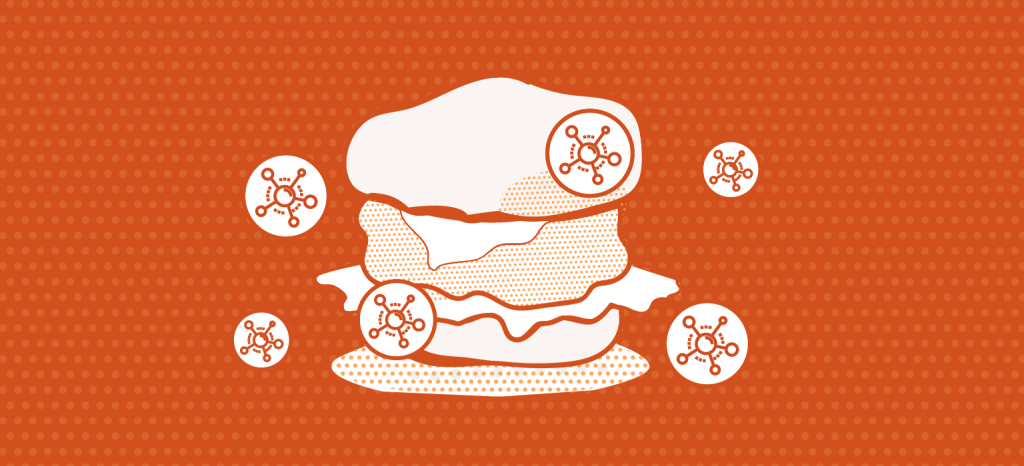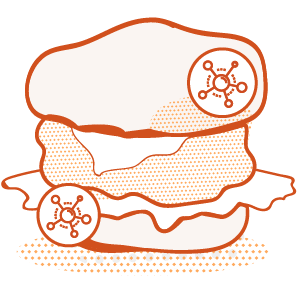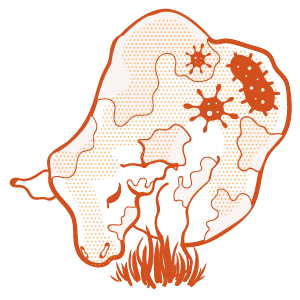Choosing Meat Alternatives That Are Healthy and Sustainable

Deciding whether to eat animal products is a personal choice. Some people avoid eating meat for moral reasons; others may eliminate red meat from their diets because of the high risk for heart disease.
However, the debate about how much meat, if any, should be included in one’s daily diet has grown alongside the alarm over climate change. Both in the United States and abroad, policymakers are including sustainability as a factor in dietary guidance.
According to “Designing a Sustainable Diet (PDF, 207 KB)” — a report co-authored by Kim Robien, associate professor at the Milken Institute School of Public Health at the George Washington University — no country has achieved a sustainable diet.
As stated in the report: “Current and emerging dietary patterns threaten human health in developing and developed countries and negatively affect long-term food security. It is thus not unreasonable that government-issued dietary guidelines take sustainability into account.”
Environmental and animal welfare concerns have cleared the way for more plant-based food products to enter the marketplace. Vegetarian meals and meat-free protein alternatives are increasingly available from grocery aisles, fast-food establishments and sit-down restaurants. However, it is not yet clear if plant-based meat alternatives are as healthy and sustainable as their manufacturers claim.
Tips for Reading a Nutrition Label
Dietitian Sarah Waybright provided some tips on how to navigate food label information to determine whether a processed plant-based food item is healthy.
1
Look at the number of ingredients. Generally, more ingredients mean a food item is more highly processed.
2
Check the amount of sodium and added sugar (sugar not derived from a whole food).These are commonly added to processed foods.
3
Find something that is protein rich. Check to see how much protein per serving the food item contains. “Some vegetarian and vegan alternatives out there aren’t nutritional equivalents,” Waybright said.
4
Keep it balanced. The nutritional value of every food product needs to be considered within the context of a complete diet. “If you’re having saturated fat in your burger, but you have a whole-grain bun and a side salad, and there’s really no saturated fat in the rest of the meal, then that’s not a problem,” Waybright said.
Why Are Plant-Based Meat Alternatives Becoming More Popular?
Plant-based meat alternatives have existed in many forms over the years, from soy-based imitation turkey to black-bean “burger” patties. While often geared toward people adhering to vegan and vegetarian diets, these products also appeal to the increasing number of people cutting back on how much meat they consume and shifting to a “flexitarian” lifestyle: a diet that consists mostly of plant-based vegetarian meals and occasionally includes meat or fish.
The latest development of these meat alternative food products, which more closely resemble the taste and mouthfeel of actual meat, has caught the interest of this wider audience as a healthy and sustainable diet option.

Environmental Effects of the Meat Industry
As more consumers become environmentally conscious, many have started to recognize how the agriculture and livestock industries affect climate change.
The Food and Agriculture Organization reports that the livestock industry as a whole is responsible for 14.5 percent of all greenhouse gas (GHG) emissions caused by humans. The beef supply chain is the biggest contributor, accounting for 41 percent of the entire livestock industry’s GHG emissions. The production process for beef also requires more resources: Every calorie of beef consumed by humans requires 28 times more land and 11 times more water than the average of other livestock products (dairy, poultry, pork, and eggs).
As a result, many people are eating fewer animal products, or ditching them all together, to offset GHG emissions and reduce the use of resources. To meet the challenge of feeding a healthy and sustainable diet to an estimated 10 billion people by 2050, a JAMA article on the viability of plant-based meat alternatives recommends a substantial reduction in red meat consumption and shifting toward mostly plant-based dietary patterns.

Health Issues Tied to Red Meat and Highly Processed Meat
More people are choosing to avoid meat — particularly red meat and highly processed meat products — for health reasons. Researchers have found connections between consumption of animal protein and a variety of health issues.
Authors of one study published in JAMA Internal Medicine found that higher intake of plant protein was associated with lower mortality. Additionally, substitution of plant protein for animal protein, mainly for red or processed meat, was associated with lower risk of cancer-related, cardiovascular disease-related and total mortality.
In another study — co-authored by Sameera Talegawkar, an associate professor in the Department of Exercise and Nutrition Sciences at the Milken Institute School of Public Health at the George Washington University — researchers examined dietary habits of South Asians living in the United States. They found that vegetarian diets were associated with fewer cardiometabolic risk factors for this social group.

Meat Production and the Rise of Antibiotic-Resistant Bacteria
In order to meet consumer demand for meat products, some producers give animals antibiotics for growth promotion or increased feed efficiency. The Centers for Disease Control and Prevention (CDC) says that exposing animals to low doses of these drugs over a long period of time can cause bacteria to grow resistant and treatments to become less effective.
“What that does is fuel the growth of drug-resistant bacteria in those animals, and then those bacteria can contaminate meat,” said Lance Price, director of the Antibiotic Resistance Action Center (ARAC) at the Milken Institute School of Public Health at the George Washington University, in a video on meat safety.
Livestock production accounts for 70 percent of all sales of medically important antibiotics in the United States. Fortunately, efforts are being made to decrease the overuse of antibiotics on animals, but the practice has caused some consumers to be more wary of meat products and factory farming.
Understanding the Health and Environmental Effects of Plant-Based Meat Substitutes
Plant-based meat alternatives are often viewed as healthier and more sustainable food options, though that depends on the point of comparison.
Faux burger patties, for instance, are still a processed food. Depending on the level of processing, food items can lose important nutrients and phytochemicals found in plant foods. A recent study also found that diets high in ultra-processed food cause excess caloric intake and weight gain.
Nutritionists say the best way to get the nutrients you need is by eating whole foods.
“It’s always better to eat a whole food,” said Jillian McEvoy, a nutritional therapy consultant. “As an example, with grain, if you don’t soak them before preparing them, your body can’t absorb the nutrients. Most of the products on the market today are not prepared that way because they’re highly processed.”
But when compared to its animal meat counterpart, a plant-based meat alternative may have similar nutritional quality and a lower ecological footprint, said Waybright.
She said the latest plant-based burger products are made to provide a comparable amount of protein and similar nutrients, which is not always true for other vegetarian and vegan products.
“If you’re comparing [a plant-based meat alternative] to conventional cornfed, feedlot-style cattle, I would say the meat alternative might be better for both health and sustainability,” Waybright said.
Like any other processed food, plant-based meat products are safe to eat in moderation —particularly when they’re part of a diet that is full of whole foods.
Glossary: Animal Protein Alternatives
Plant-based meat alternatives use a variety of ingredients to add protein and mimic the taste and feel of real meat. This glossary includes common plant proteins used in these products and identifies potential health and environment factors consumers should consider.
Soy Protein Isolate
A processed product extracted from soybeans.
 Health Factors
Health Factors
- Soy is high in protein; however, the isolating process strips away many of its nutrients.
- Soy-based ingredients should be organic or non-GMO to avoid higher concentrations of pesticides as a result of the condensing and extraction process.
 Environment Factors
Environment Factors
- Soy farming has caused deforestation in places like Brazil, according to the World Wildlife Fund. It’s important to know where soy is sourced from when purchasing food products.
Isolated Pea Protein
Created through a process of removing fiber and starches from peas to isolate the protein.
 Health Factors
Health Factors
- While there are higher protein levels in isolated pea protein, it is lacking the nutritional benefits of the fiber and starches present in whole peas.
 Environment Factors
Environment Factors
- Pea crops have lower greenhouse gas emissions and require less land and water usage. They also have the capacity to increase soil fertility though “fixing” nitrogen gas in the atmosphere to bioavailable forms that can be used with plants.
- Water and energy inputs associated with pea protein are higher than that of whole dried peas or pea flour as a result of the process of extracting the protein from the whole peas.
Mycoprotein
High-protein, high-fiber, non-mushroom-producing, lab-grown fungi.
 Health Factors
Health Factors
- Mycoprotein is typically is used in foods that are high in sodium and additives such as dyes, gums and preservatives.
- Because this food product is derived from fungi, some people with sensitivities to mold or other fungi may experience adverse effects, such as allergic reactions and gastrointestinal issues.
 Environment Factors
Environment Factors
- Data is limited on a full life-cycle analysis of mycoprotein production.
Leghemoglobin
Protein that carries heme, an iron-containing molecule, found in the root of leguminous plant genes (typically soy).
 Health Factors
Health Factors
- Higher intake of heme iron has been associated with increased body iron stores and elevated risk of developing Type 2 diabetes.
- The Food and Drug Administration (FDA) has not yet officially approved its safety for consumption. However, this does not mean the FDA considers these products to be unsafe, meaning they can still be sold for human consumption.
 Environment Factors
Environment Factors
This ingredient is used to make plant-based meat alternatives taste more like actual meat and is generally considered to reduce the need of land and water usage.
Sources:
“Meat Alternative Products.” Healthcare Without Harm. Accessed September 26, 2019.
“Sustainable Agriculture.” World Wildlife Fund. Accessed September 26, 2019.
“Managing Cover Crops Profitably.” Sustainable Agriculture Research and Education. Accessed September 26, 2019.
Jacobson, M. F., & DePorter, J. (2018). Self-reported adverse reactions associated with mycoprotein (Quorn-brand) containing foods. Annals of Allergy, Asthma & Immunology, 120(6), 626–630. doi:10.1016/j.anai.2018.03.020
Bao, W., Rong, Y., Rong, S., & Liu, L. (2012). Dietary iron intake, body iron stores, and the risk of Type 2 diabetes: A systematic review and meta-analysis. BMC Medicine, 10(1). doi:10.1186/1741-7015-10-119
Resources for Further Reading
Citation for this content: MPH@GW, the George Washington University online Master of Public Health program.


